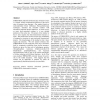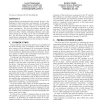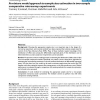1199 search results - page 4 / 240 » How to Compare the Power of Computational Models |
TVLSI
2008
13 years 5 months ago
2008
Applications in computer networks often require high throughput access to large data structures for lookup and classification. While advanced algorithms exist to speed these search...
CGF
2005
13 years 5 months ago
2005
Deformable models are a powerful tool in both computer graphics and computer vision. The description and implementation of the deformations have to be simultaneously flexible and ...
APBC
2004
13 years 7 months ago
2004
THEMATICS (Theoretical Microscopic Titration Curves) is a simple, reliable computational predictor of the active sites of enzymes from structure. Our method, based on well-establi...
EENERGY
2010
13 years 9 months ago
2010
Energy-efficient communication has recently become a key challenge for both researchers and industries. In this paper, we propose a new model in which a Content Provider and an In...
BMCBI
2008
13 years 6 months ago
2008
Background: Choosing the appropriate sample size is an important step in the design of a microarray experiment, and recently methods have been proposed that estimate sample sizes ...



